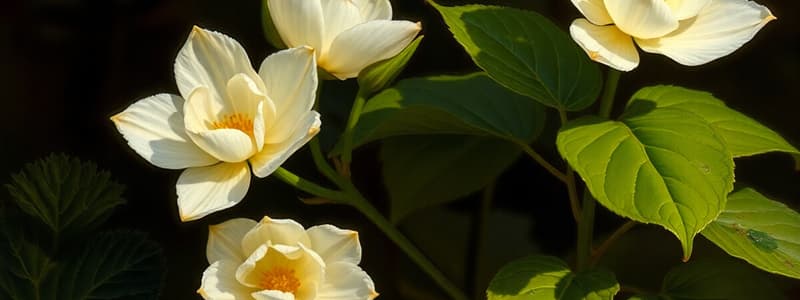Podcast
Questions and Answers
What role do cytokinins play in plants during the spring?
What role do cytokinins play in plants during the spring?
- They stimulate root growth exclusively.
- They prevent water loss during heat stress.
- They transport to shoots and activate dormant buds. (correct)
- They inhibit fruit ripening processes.
How does ethylene affect the ripening process in fruits?
How does ethylene affect the ripening process in fruits?
- It prevents leaf senescence in ripening fruits.
- It increases chlorophyll production in fruits.
- It inhibits the ripening process.
- It promotes the degreening of certain fruits. (correct)
What is one of the primary functions of abscisic acid (ABA) in plants?
What is one of the primary functions of abscisic acid (ABA) in plants?
- To promote rapid leaf growth.
- To induce stomatal closure during stress. (correct)
- To enhance flower production.
- To stimulate seed germination.
What was the main focus of W.W. Garner and H.A. Allard's study in 1920?
What was the main focus of W.W. Garner and H.A. Allard's study in 1920?
Which of the following statements about cytokinins is inaccurate?
Which of the following statements about cytokinins is inaccurate?
What is the primary role of the hormone florigen in plants?
What is the primary role of the hormone florigen in plants?
Which type of plant flowers when the day length is shorter than its critical day length?
Which type of plant flowers when the day length is shorter than its critical day length?
What happens when a short-day plant receives more than its critical day length?
What happens when a short-day plant receives more than its critical day length?
What is the primary reason for apical dominance in plants?
What is the primary reason for apical dominance in plants?
What is the relationship between critical day length and the total length of day in short-day plants?
What is the relationship between critical day length and the total length of day in short-day plants?
Which of the following effects does IAA have on plant growth?
Which of the following effects does IAA have on plant growth?
Which of the following plants is classified as a long-day plant (LDP)?
Which of the following plants is classified as a long-day plant (LDP)?
What is the most commonly occurring gibberellin?
What is the most commonly occurring gibberellin?
Which process is significantly influenced by cytokinins?
Which process is significantly influenced by cytokinins?
What is the effect of gibberellins on dwarf cultivars?
What is the effect of gibberellins on dwarf cultivars?
What is the primary role of auxin in the prevention of abscission?
What is the primary role of auxin in the prevention of abscission?
Which substance is primarily responsible for overcoming cold requirements in some seeds?
Which substance is primarily responsible for overcoming cold requirements in some seeds?
What is the significance of callus formation in plant tissue culture?
What is the significance of callus formation in plant tissue culture?
What is the primary outcome of vernalization in plants?
What is the primary outcome of vernalization in plants?
Which of the following temperatures is most ineffective for vernalization?
Which of the following temperatures is most ineffective for vernalization?
What hormone is induced by the cold treatment during vernalization?
What hormone is induced by the cold treatment during vernalization?
What effect does a short flash of light have on plants with a critical night length?
What effect does a short flash of light have on plants with a critical night length?
Which form of phytochrome absorbs red light?
Which form of phytochrome absorbs red light?
In which phase does the thermophase occur according to the phasic development theory?
In which phase does the thermophase occur according to the phasic development theory?
What is the primary result of the vernalization process in plants?
What is the primary result of the vernalization process in plants?
Which factor is NOT critical for effective vernalization?
Which factor is NOT critical for effective vernalization?
What does PFR convert to under continuous darkness?
What does PFR convert to under continuous darkness?
What is the process called that reverses the effects of vernalization?
What is the process called that reverses the effects of vernalization?
Who proposed the hormonal theories related to vernalization?
Who proposed the hormonal theories related to vernalization?
Which pigment is identified as photoreversible in the leaf?
Which pigment is identified as photoreversible in the leaf?
Which of the following statements is true regarding the vernalization stimulus?
Which of the following statements is true regarding the vernalization stimulus?
Which of the following crops can be made to remain vegetative for longer periods through light manipulation?
Which of the following crops can be made to remain vegetative for longer periods through light manipulation?
What temperature range is ideal for cold treatment during vernalization?
What temperature range is ideal for cold treatment during vernalization?
What phenomenon was first noted by Klippart in 1857?
What phenomenon was first noted by Klippart in 1857?
Flashcards are hidden until you start studying
Study Notes
Apical Dominance
- Higher auxin levels in apical buds are responsible for apical dominance, suppressing the growth of lateral buds.
### Auxin
- Promotes root formation when applied to stem cuttings.
- Prevents abscission (leaf fall) when present in higher concentrations on the distal end of the abscission zone.
- Induces parthenocarpy, the development of fruit without fertilization.
- Auxin application can induce cell elongation and adventitious root formation in callus tissue.
Gibberellins
- Discovered by Kurosawa in 1928 while studying rice plants infected with the fungus Gibberella fujikuroi.
- The infected plants exhibited excessive stem elongation, a symptom known as "bakane disease".
- Gibberellic acid (GA3) is the most common gibberellin.
- Produced primarily in the shoot apex, leaf primordial, and root system.
- Promote stem growth, cell division, and cell elongation.
- Can overcome dormancy in seeds and buds.
- Translocates easily in both directions within the plant.
- Used commercially to increase fruit size in grapes, stimulate seed germination and seedling growth, and overcome cold requirements for seed germination.
Cytokinins
- Promote cell division.
- Found in actively dividing tissues such as embryos, germinating seeds, and young developing fruits.
- Roots supply cytokinins to the shoots.
- Interact with auxins to influence tissue differentiation.
- Can stimulate bud formation.
- Promote bud activation and expansion in spring.
- Used in tissue cultures to induce shoot development.
- May slow or prevent leaf senescence.
Ethylene
- Gaseous hormone produced in actively growing meristems, ripening fruits, senescing flowers, germinating seeds, and in response to bending, wounding, or bruising.
- Diffuses readily throughout the plant.
- Promotes leaf senescence and abscission.
- Increases female flower production in cucumbers, leading to increased fruit yield.
- Degreening of citrus fruits by breaking down chlorophyll and revealing underlying pigments.
Abscisic Acid (ABA)
- Found throughout the plant and moves readily.
- Synthesized in leaves.
- Interacts with other hormones, counteracting the growth-promoting effects of auxins and gibberellins.
- Plays a role in leaf and fruit abscission, dormancy in seeds, and dormancy in perennial flowers and shrubs.
- Induces closure of stomata in leaves, suggesting a role in plant stress responses, such as water stress, heat stress, and high salinity stress.
Photoperiodism
- The biological measurement of day and night lengths.
- Controls flowering by responding to changes in day length.
- Discovery: Garner and Allard (1920) studied flowering in the Maryland Mammoth variety of tobacco plant.
- Mechanism:
- Photoperiod is perceived by leaves.
- A hypothetical hormone called "florigen" induces flowering.
- Classification of Responses:
- Short-day Plants (SDPs): Flower when day length is shorter than a critical day length (e.g., soybean, chrysanthemum).
- Long-day Plants (LDPs): Flower when day length is longer than a critical day length (e.g., oat, radish, spinach).
- Long-short Day Plants (LSDPs): Flower after a sequence of long days followed by short days (e.g., jasmine, Bryophyllum).
- Short-long Day Plants (SLDPs): Flower after a sequence of short days followed by long days (e.g., winter rye).
- Day-Neutral Plants (DNPs): Flower regardless of day length (e.g., balsam, maize).
Photoperiod Mechanism
- Phytochrome: A photoreversible pigment exists in two interconvertible forms:
- Pr: Absorbs red light.
- Pfr: Absorbs far red light.
Vernalization
- Promoting flowering with cold.
- Process where a cold treatment given to fully hydrated seeds or growing plants promotes flowering.
- Dry seeds do not respond to cold treatment.
- Shortens the vegetative phase of the plant, resulting in early flowering.
- History:
- Klippart (1857) observed low temperature requirement for flowering in winter wheat and spring wheat.
- Lysenko (1938) introduced the term "vernalization" to describe low-temperature promotion of flowering.
- Chourad (1960) defined vernalization as "the acquisition or acceleration of the ability to flower by a chilling treatment."
Vernalization Process
- Seeds are germinated and then subjected to cold treatment (0°C to 5°C) for a period ranging from days to weeks.
- The cold treatment prepares the plant for flowering.
- The stimulus is often perceived by the apical meristem, but in some species, root and leaf dividing cells can also respond.
- A hormone called "vernalin" is induced by vernalization (discovered by Melcher in 1936).
- The vernalization stimulus can be transmitted through grafting.
- Plant age influences responsiveness to cold treatment.
Vernalization Factors
- Temperature: Optimal temperature range is 1-6°C. Higher temperatures decrease effectiveness, and temperatures above 12-14°C are ineffective.
- Oxygen: Vernalization is aerobic, requiring oxygen for efficiency.
- Water: Sufficient water is essential. Dry seeds cannot be vernalized.
Theories of Vernalization
- Phasic Development Theory: Lysenko (1934) proposed a series of development phases stimulated by environmental factors. Vernalization accelerates the "thermophase" which is followed by a "photophase" requiring light.
- Hormonal Theory: Melcher (1939) suggested that chilling treatment induces the formation of "vernalin," a hormonal signal that initiates flowering.
Devernalization
- Reversion of vernalization by high temperature treatment.
- High temperatures can reverse the effects of vernalization in seeds and buds.
Studying That Suits You
Use AI to generate personalized quizzes and flashcards to suit your learning preferences.




